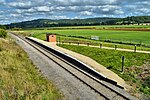Hailes, Gloucestershire

Hailes (also spelt Hayles) is a small village and former civil parish, now in the parish of Stanway, in the Tewkesbury district, in Gloucestershire, England, 2 miles (3.2 km) north-east of Winchcombe. The village lies at the foot of the Cotswold escarpment. The remains of Hailes Abbey, a Cistercian abbey active from 1246 to 1539, are here. In 1931 the parish had a population of 83. Hailes was mentioned in the Domesday Book of 1086, in the form Heile. The toponym is of unknown origin. One toponymist has suggested that the name derives from an unrecorded British name for the stream flowing through the village, Saliā ("the dirty one"). In the 11th or early 12th century, Hailes Castle was built here, but was probably demolished in the 1240s to make way for the construction of Hailes Abbey. Hailes was a chapelry of the ancient parish of Didbrook, and became a separate parish in 1837. In 1866 it became a civil parish. On 1 April 1935 the civil parish of Hailes was abolished, and most of it was absorbed into the parish of Stanway. Between 1928 and 1960 the village was served by Hayles Abbey Halt railway station on the Honeybourne Line. The station was reopened in 2017 to serve the heritage Gloucestershire Warwickshire Steam Railway.
Excerpt from the Wikipedia article Hailes, Gloucestershire (License: CC BY-SA 3.0, Authors, Images).Hailes, Gloucestershire
Tewkesbury Stanway
Geographical coordinates (GPS) Address Nearby Places Show on map
Geographical coordinates (GPS)
| Latitude | Longitude |
|---|---|
| N 51.9695 ° | E -1.9281 ° |
Address
GL54 5PB Tewkesbury, Stanway
England, United Kingdom
Open on Google Maps









